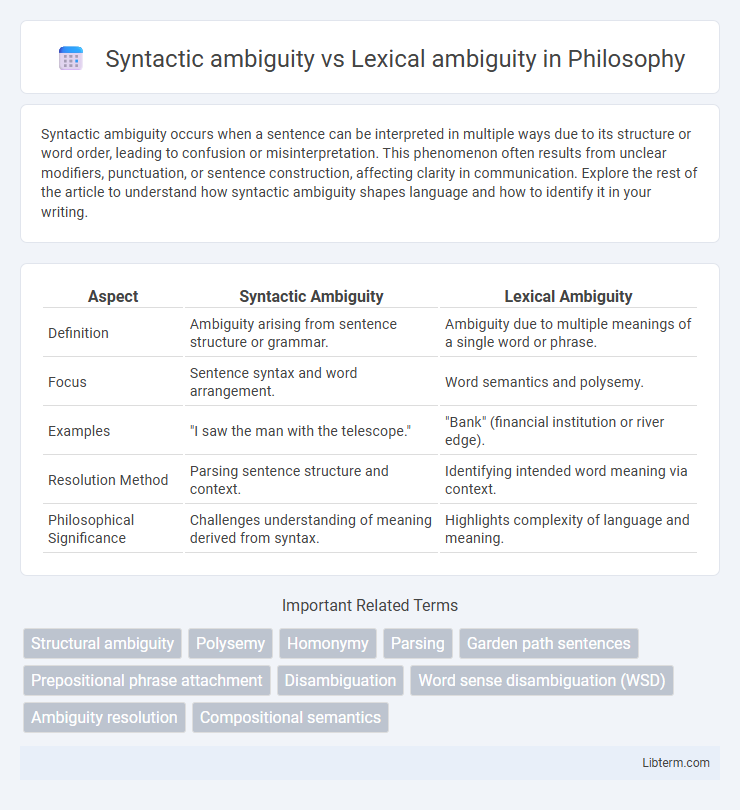Syntactic ambiguity occurs when a sentence can be interpreted in multiple ways due to its structure or word order, leading to confusion or misinterpretation. This phenomenon often results from unclear modifiers, punctuation, or sentence construction, affecting clarity in communication. Explore the rest of the article to understand how syntactic ambiguity shapes language and how to identify it in your writing.
Table of Comparison
| Aspect | Syntactic Ambiguity | Lexical Ambiguity |
|---|---|---|
| Definition | Ambiguity arising from sentence structure or grammar. | Ambiguity due to multiple meanings of a single word or phrase. |
| Focus | Sentence syntax and word arrangement. | Word semantics and polysemy. |
| Examples | "I saw the man with the telescope." | "Bank" (financial institution or river edge). |
| Resolution Method | Parsing sentence structure and context. | Identifying intended word meaning via context. |
| Philosophical Significance | Challenges understanding of meaning derived from syntax. | Highlights complexity of language and meaning. |
Introduction to Ambiguity in Language
Ambiguity in language arises when a word, phrase, or sentence has multiple meanings, leading to different interpretations. Syntactic ambiguity occurs when the sentence structure allows for more than one meaning, while lexical ambiguity involves a single word possessing multiple meanings. Understanding these distinctions is crucial for natural language processing and effective communication.
Defining Syntactic Ambiguity
Syntactic ambiguity occurs when a sentence can be interpreted in multiple ways due to its grammatical structure, leading to confusion about the intended meaning. This type of ambiguity arises from the arrangement of words and phrases, rather than the meanings of individual words. Understanding syntactic ambiguity is crucial for natural language processing and improves clarity in communication and language parsing algorithms.
Defining Lexical Ambiguity
Lexical ambiguity occurs when a single word has multiple meanings, causing confusion in interpretation without contextual clarification. This differs from syntactic ambiguity, which arises from sentence structure allowing multiple interpretations. Understanding lexical ambiguity is essential for natural language processing and improving linguistic precision in communication.
Key Differences Between Syntactic and Lexical Ambiguity
Syntactic ambiguity arises from a sentence's structure, causing multiple possible interpretations due to how words relate grammatically, whereas lexical ambiguity stems from a single word having multiple meanings. Key differences include syntactic ambiguity involving the arrangement of phrases or sentence structure, while lexical ambiguity is centered on polysemous or homonymous words. Understanding these distinctions is crucial in natural language processing tasks to accurately interpret meaning and context.
Common Examples of Syntactic Ambiguity
Syntactic ambiguity occurs when a sentence can be interpreted in multiple ways due to its structure, such as "I saw the man with the telescope," which can mean either the observer used a telescope or the man had one. Another common example is "Visiting relatives can be annoying," where it is unclear whether relatives who visit are annoying or the act of visiting relatives is annoying. These examples highlight how sentence construction affects meaning, contrasting with lexical ambiguity, which arises from single words with multiple meanings.
Common Examples of Lexical Ambiguity
Lexical ambiguity occurs when a word has multiple meanings, such as "bank," which can refer to a financial institution or the side of a river. Common examples include words like "bat" (an animal or a sports equipment) and "lead" (to guide or a type of metal). This ambiguity contrasts with syntactic ambiguity, where sentence structure causes multiple interpretations.
Impact of Ambiguity on Communication
Syntactic ambiguity, caused by unclear sentence structure, and lexical ambiguity, arising from words with multiple meanings, both disrupt effective communication by generating misunderstandings and confusion. Misinterpretations due to ambiguous syntax or vocabulary slow down information processing and can lead to errors in decision-making across various contexts such as legal, medical, and technical communications. Clarity in language use and disambiguation strategies significantly improve message precision, enhancing overall communication efficiency.
Ambiguity in Computational Linguistics
Syntactic ambiguity arises when a sentence structure allows multiple interpretations due to unclear grammatical relationships, whereas lexical ambiguity occurs when a single word has multiple meanings in a context. In computational linguistics, resolving syntactic ambiguity involves parsing algorithms that generate multiple parse trees to identify the most plausible interpretation. Lexical ambiguity is addressed through word sense disambiguation techniques using context clues, semantic networks, and machine learning models to determine the correct meaning of ambiguous words.
Resolving Ambiguity: Strategies and Techniques
Resolving syntactic ambiguity involves parsing techniques that analyze sentence structure to clarify meaning, such as using constituency and dependency grammar trees. Lexical ambiguity resolution relies on word sense disambiguation methods, including context-based algorithms and machine learning models that leverage semantic networks like WordNet. Both strategies benefit from leveraging corpus-based frequency data and probabilistic models to determine the most likely interpretation in natural language processing applications.
Conclusion: The Importance of Understanding Ambiguity
Recognizing the distinction between syntactic ambiguity, which arises from sentence structure, and lexical ambiguity, stemming from multiple meanings of a word, is essential for effective communication and language processing. Understanding these ambiguities enhances accurate interpretation in natural language processing (NLP), linguistics, and artificial intelligence applications. Mastery of ambiguity detection improves text analysis, machine translation, and human-computer interaction outcomes.
Syntactic ambiguity Infographic

 libterm.com
libterm.com